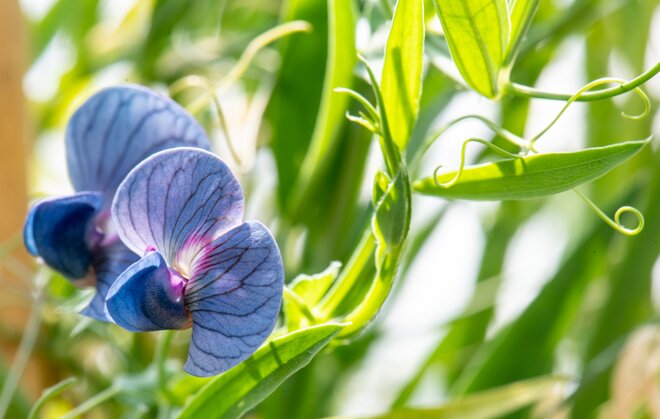Fast-Tracking Food Security Using Space Science
 Grasspea at ICARDA’s facilities at Marchouch Station, Morocco. Photo: Michael Major/Crop Trust
Grasspea at ICARDA’s facilities at Marchouch Station, Morocco. Photo: Michael Major/Crop Trust7 April 2021
Plant breeders developing new crop varieties are finding success after shifting their gaze from the fields to the stars.
Scientists at the International Center for Agricultural Research in the Dry Areas (ICARDA) in Rabat, Morocco, are using a plant-growing method developed by NASA to develop new varieties of grasspea, a hardy crop grown in South Asia and sub-Saharan Africa.
NASA developed speed breeding, or rapid generation advancement, to safeguard the food supply and psychological well-being of astronauts during long-haul missions of the future. Aboard the International Space Station, astronauts use LED lamps to cultivate vegetables without sunlight.
But it turns out this is also an excellent way to accelerate the breeding process on Earth. Depending on the crop, speed breeding exposes the plant to artificial light for as long as 22 hours a day, stimulating growth. And, by cultivating the plants in a controlled environment, they are protected from unpredictable weather conditions. It’s a promising way to help maintain food security and nutrition as climate change accelerates.
“It used to take six to seven years to breed a new grasspea variety, or up to 12 years when wild relatives are used as parents,” says Shiv Kumar Agrawal, who leads ICARDA’s Food Legumes Program. “But by increasing the hours of light and controlling the temperature, the plant completes its growth cycle faster. This means we can grow more generations per year, and a new variety can be ready for farmers’ fields in roughly five years.”
ICARDA started its speed breeding program in 2018 and has also used the technique to improve durum wheat, barley, chickpea and lentil. In the Templeton Pre-Breeding Project, led by the Crop Trust and funded by the Templeton World Charity Foundation Inc., ICARDA uses crop wild relatives to improve grasspea, and speed breeding is a key part of the process.

A grasspea speed breeding facility at ICARDA in Rabat, Morocco. Photo by Kamal Hejjaoui
The endeavor builds upon work by the Crop Trust’s Crop Wild Relatives (CWR) Project on grasspea. The 11-year initiative collects important species of crop wild relatives—undomesticated cousins of domesticated crops—globally, ensures their long-term conservation and uses them to adapt agriculture to the effects of climate change.
Grasspea is a particularly promising crop to work with.
“For smallholder farmers, it offers enormous potential to ensure food security in the face of climate change,” says CWR Project leader Benjamin Kilian. “After soybean, it has the highest protein content level of any legume and its exceptional resilience makes it an excellent ‘insurance’ crop for farmers to rely on.”
Grasspea can withstand environmental extremes like droughts and floods that cause other crops to fail. Rich in iron, zinc and protein content, this annual legume is used as livestock feed, a grain crop for humans and fertilizer for farming systems.
“It’s a low-cost crop that can be simply thrown into a field and will probably grow just fine,” Agrawal says. “It doesn’t require any fertilizer, nor much irrigation. As climate change progresses, this multi-purpose crop will be increasingly important as livestock fodder and human food. Speed breeding will play a key role along the way.”
However, some grasspea varieties also contain a neurotoxin that can cause paralysis in humans if consumed exclusively and steadily over a three-month period.
In cooperation with the UK’s John Innes Centre—which helped pioneer speed breeding—ICARDA researchers are breeding high-yielding grasspea varieties with low toxin levels for farmers in South Asia and East Africa. The ICARDA genebank’s speed breeding facility in Rabat can accommodate about 500,000 plants in a single glasshouse under controlled light and temperature conditions.
“Some of the wild relatives of cultivated grasspea plants have very low levels of neurotoxins,” says Agrawal. “Our goal is to transfer useful traits from wild relatives to cultivated grasspea to develop a crop of the future.”
ICARDA breeders are also using crop wild relatives to bring other traits from the wild into domesticated plants, including resistance to the parasitic plant Orobanche, known as broomrape.
However, speed breeding does pose several investment challenges, requiring specialist staff, infrastructure and power supplies to run the facilities. To reduce the expense of electricity, ICARDA is planning to switch to solar panels for energy.
But, despite these obstacles, the benefits of speed breeding are indisputable, showing a quicker path to developing climate-smart crops for farmers.
“By harnessing the genetic diversity found in the wild relatives of grasspea and combining that with modern speed breeding technology, we are producing crops of the future at a faster rate than generations of farmers and breeders before us,” says Agrawal.
Categories: Crop Wild Relatives, Genebanks, Templeton Pre-Breeding Project, Grasspea
